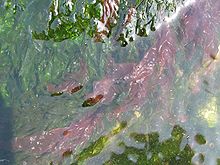- Porphyra
-
For the color known in Greek as porphyra, see Tyrian purple.
Porphyra 
Porphyra yezoensis Scientific classification Domain: Eukaryota (unranked): Archaeplastida Phylum: Rhodophyta Class: Rhodophyceae Order: Bangiales Family: Bangiaceae Genus: Porphyra Porphyra is a foliose red algal genus of laver, comprising approximately 70 species.[1] It grows in the intertidal zone, typically between the upper intertidal zone and the splash zone in cold waters of temperate oceans. In East Asia, it is used to produce the sea vegetable products nori (in Japan) and gim (in Korea), the most commonly eaten seaweed. There are considered to be 60 to 70 species of Porphyra worldwide[2] and seven in the British Isles.[3]
Contents
Life cycle
Porphyra displays a heteromorphic alternation of generations[4]. The thallus we see is the haploid generation; it can reproduce asexually by forming spores which grow to replicate the original thallus. It can also reproduce sexually. Both male and female gametes are formed on the one thallus. The female gametes while still on the thallus are fertilized by the released male gametes, which are non-motile. The fertilised, now diploid, carposporangia after mitosis produce spores (carpospores) which settle, then bore into shells, germinate and form a filamentous stage. This stage was originally thought to be a different species of alga, and was referred to as Conchocelis rosea. The fact that Conchocelis was the diploid stage of Porphyra was discovered by the British phycologist Kathleen Mary Drew-Baker in 1949 for the European species Porphyra umbilicalis[5]. It was later shown for species from other regions as well[1][6].
Food
Most human cultures with access to Porphyra use it as a food or somehow in the diet, making it perhaps the most domesticated of the marine algae,[7] known as laver, nori (Japanese), amanori (Japanese),[8] zakai, gim (Korean),[8] zicai (Chinese),[8] karengo, sloke or slukos.[2] The marine red alga Porphyra has been cultivated extensively in many Asian countries as an edible seaweed used to wrap the rice and fish that compose the Japanese food sushi, and the Korean food gimbap. In Japan, the annual production of Porphyra spp. is valued at 100 billion yen (US$ 1 billion).[9]
Species
- Porphyra abbottiae V.Krishnamurthy, Red laver[10]
- Porphyra leucosticta Thur.
- Porphyra linearis Grev.
- Porphyra miniata (C.Agardh)
- Porphyra purpurea (Roth)
- Porphyra tenera
- Porphyra umbilicalis (L.) J.Agardh.[11]
- Porphyra yezoensis Ueda
References
- ^ a b Brodie, J.A. and Irvine, L.M. 2003. Seaweeds of the British Isles. Volume 1 Part 3b. The Natural History Museum, London.ISBN 1 898298 87 4
- ^ a b Kain, J.M. 1991. Cultivation of attached seaweeds. in Guiry, M.D. and Blunden, G. 1992. Seaweed Resources in Europe: Uses and Potential. John Wiley and Sons, Chichester ISBN 0 471 92947 6
- ^ Hardy, F.G. and Guiry, M.D. 2006. A Check-list and Atlas of the Seaweeds of Britain and Ireland. British Phycological Society, London. ISBN 3 906166 35 X
- ^ Porphyra life cycle
- ^ Drew, Kathleen M. (1949). "Conchocelis-phase in the life-history of Porphyra umbilicalis (L.) Kütz". Nature 164 (4174): 748–749. doi:10.1038/164748a0. http://www.nature.com/nature/journal/v164/n4174/abs/164748a0.html.
- ^ Thomas, D. 2002. Seaweeds. The Natural History Museum, London. ISBN 0 565 09175 1
- ^ Mumford, T.F. and Miura, A. 4.Porphyra as food: cultivation and economics. in Lembi, C.A. and Waaland, J.R. 1988. Algae and Human Affairs. Cambridge University Press, Cambridge. ISBN 0-521-32115-8
- ^ a b c Abbott, Isabella A (1989). Lembi, Carole A.; Waaland, J. Robert. eds. Algae and human affairs. Cambridge University Press, Phycological Society of America. pp. 141. ISBN 9780521321150.
- ^ Aoki, Y. and Kamei, Y. 2006 Preparation of recombinant polysaccharide-degrading enzymes from the marine bacterium, Pseudomonas sp. ND137 for the production of protoplasts of Porphyra yezoensis Eur. J. Phycol. 41: 321 - 328
- ^ Turner, Nancy J. (2003). Food plants of coastal First Peoples. University of Washington Press. p. 21. ISBN 9780774805339.
- ^ Morton, O. 1994. Marine Algae of Northern Ireland. Ulster Museum, Belfast. ISBN 0 90076128 8
External links
- http://www.mbari.org/staff/conn/botany/reds/lisa/consume.htm Porphyra human consumption.
Categories:- Red algae
- Sea vegetables
- Seaweeds
Wikimedia Foundation. 2010.
